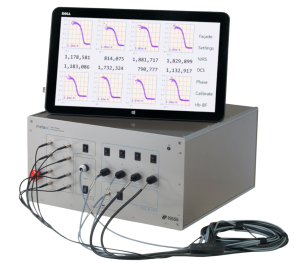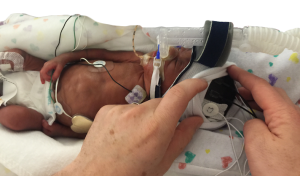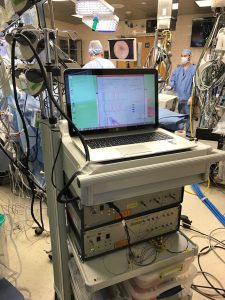 I am perhaps best known for efforts in developing and translating frequency-domain near infrared spectroscopy (FDNIRS) to quantify hemoglobin concentration and oxygenation.
I am perhaps best known for efforts in developing and translating frequency-domain near infrared spectroscopy (FDNIRS) to quantify hemoglobin concentration and oxygenation.

I led the development of the first FDNIRS system, which has been disseminated
commercially with customers in North and South America, Europe, Asia, and Australia. This FDNIRS system and the multi-distance data analysis method I developed are considered the gold standards for the quantification of the absorption and scattering coefficients of biologicaltissues. More recently, I added to the hemoglobin measures a measure of blood flow by using diffuse correlation spectroscopy (DCS). I developed the first commercially available fully integrated FDNIRS-DCS system (MetaOx, ISS Inc.) and demonstrated the clinical relevance of these measures not only because of the quantification of the vascular measures, but because the combination of the two provides a measure of oxygen consumption which is fundamental to the assessment of brain health. The application of these devices in newborns has generated several pioneering publications on brain development, brain health and response to therapy. Current active preclinical and clinical studies are:
Neuro-monitoring of newborns during therapeutic-hypothermia
Lead by Dr. Ellen Grant at BCH, we are participating on a study on newborn treated with therapeutic-hypothermia. Neonatal encephalopathy continues to cause significant morbidity, and the lack of a bedside tool to assess newborn brain health limits progress in neonatal care that could improve neurodevelopmental outcomes. The overall goal of this study is to determine if FDNIRS-DCS can screen for acute neonatal encephalopathy, assess response to treatment, and predict outcomes in a population of at-risk neonates
Cerebral blood flow monitor for extreme low-birth weight infants
 In collaboration with Drs. Terrie Inder, Mohamed El-Dib and Brian Walsh at BWH we are developing a novel DCS system optimized for quantitative monitoring of cerebral blood flow index in extremely premature infants. The successful development, validation and
In collaboration with Drs. Terrie Inder, Mohamed El-Dib and Brian Walsh at BWH we are developing a novel DCS system optimized for quantitative monitoring of cerebral blood flow index in extremely premature infants. The successful development, validation and
demonstration of clinical feasibility and effectiveness of our proposed technology will lead to new patient management approaches for reducing neurological injury, protecting neurocognitive function, and reducing the overall morbidity and mortality associated with prematurity.
Neuromonitoring during Carotid endarterectomy
Together with Drs. Eric Pierce and Mirela Simon at MGH we are developing and testing a combined near infrared spectroscopy (NIRS) and diffuse correlation spectroscopy (DCS) device optimized for quantitative monitoring of cerebral blood flow and oxygen consumption during Carotid endarterectomy (CEA).
Neuromonitoring during cardiopulmonary bypass surgery
Finally, I am pursuing the clinical adoption of NIRS and DCS to monitor the adequacy of cerebral perfusion and oxygenation during anesthesia in the operating room. To this aim together with Drs. Jason Qu and Stefan Carp at MGH we are testing state-of-the art non-invasive brain health monitoring tools to provide real-time feedback on multiple aspects of brain function during bypass procedures. In the long term, we hope an effective neuromonitoring tool could be used to provide personalized care and reduce negative outcomes from major cardio-vascular surgery.
